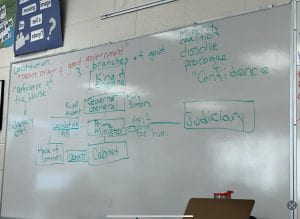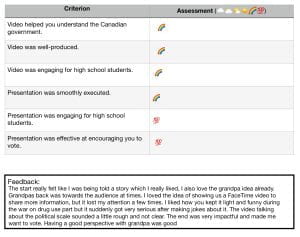🤷♀️ Where I started
In Grade 5, I distinctly remember learning that there are municipal, provincial, and federal governments in Canada. And that there are taxes. Since then, anything about government has seemed to disappear from my memory. When we started this project, I remember internally complaining about the fact that I had to spend the next month or so learning about something “so boring.” I never knew why there were different names on the election signs in North Vancouver than the signs just across the bridge. I didn’t really understand why we had different parties or that the Governor General even existed. This is where I was at despite my family being somewhat knowledgeable about the government and a great grandfather who was a speaker for the house for Alberta.
📍Where I am now
The driving questions are: “why do politics matter,” “why should we bother,” and “how can we engage young people in the voting process.” At this time, not only has my knowledge about the government increased but also my understanding of why it should matter to me.
🧭 How did I get here
The Inner-workings of our Government:
To start this project off we built our knowledge of how our governments are run. We listened to lectures from Ms. Madsen, watched videos, looked at visuals, and did daily activities to apply why we learned.

What I did well: Knowing more and more how I learn, I didn’t just type everything the teacher was saying, instead I drew what she was drawing on the board. I added other drawings to it so I could remember and understand the content more. Whenever someone asked me a question, I found that I could visualize where in the chart the information was, which helped me access it. Something else that I did really well was making a storyboard. This was not required for the government video, but I knew I could help my group be organized if we had a visual plan (even if the drawings were stick people), and help myself see what we needed to get done.

Where I pushed my thinking: The goals of the Government video pushed my thinking. We had to create an informative video for teenage on a topic I knew many of them found boring and somehow keep them engaged. Together my group decided that to do this, we should include different medias by having a video of us and animations that moved around. We also made it seem less than a just an informative video and more like someone helping someone out by explaining it. I also needed to push myself when I not only helped write the script, but did more animation than I thought I would need to do. Animation is not one of my strengths but the video turned out well.
Lord of The Flies:
To learn about the idea of social contract and human nature, we read William Golding’s Lord of The Flies and did group discussions.

What I did well: I TALKED. A LOT! (for me, at least). For this part of the project, we had to do a group discussion with Ms. Madsen. I was very nervous about this since I don’t enjoy talking in groups or to teachers, and this was both. But I was determined and ended up talking more then I have in any past class discussions. It may not have actually seemed like a lot but I was very proud of myself that I tried to talk every time I had something to add, including being the first student to talk in my group at the beginning.
Where I pushed my thinking: Along with reading the book, I also listened to the book so I could take better notes. The analysis of my notes and the specific questions we were asked, was the basis of what I shared and contributed in group discussions. Where I pushed myself was in the analysis of the book. I had heard of this book from my Mom and many non-PLP classmates but when I started reading this book it wasn’t my favourite. I found the word choices and the amount of descriptions very confusing. When I was done the book, I was very concerned because I did not think I could make connections between the book and the questions. In the end, I talked to friends, family members, and processed the book more and wrote my ideas down, making good connections that you can see here.
The Final Product:
For the final product, we had to create a 10 minute presentation that included our government video, showed our research about current issues, all to convince young people to vote.

What I did well: My communication skills and collaboration skills were strong in the final product. I made sure that everyone had something to do, that they were doing something that was one of their strengths, and that they came in early the day of our presentation so that we could practice. I also helped write the script and researched the political issue I was in charge of as well as helping others find sources for their research.
 Where I pushed my thinking: In the creation of the final presentation about “why young people should vote,” I pushed myself to find ways to make the presentation engaging, and also to problem solve when we ran into issues. Our judge’s panel was made up of Grade 10 and 12 students, which meant that everything in our presentation needed to capture their
Where I pushed my thinking: In the creation of the final presentation about “why young people should vote,” I pushed myself to find ways to make the presentation engaging, and also to problem solve when we ran into issues. Our judge’s panel was made up of Grade 10 and 12 students, which meant that everything in our presentation needed to capture their  attention. My group decided that Noah should be an old man with outdated views and who kept interrupting us. This was funny and broke up the longer sections. We also made it seem like we were “FaceTiming” a person who then talked about one of the issues and we set our whole video up as a ted talk. I personally had the idea to split up the long government video into two parts so that the judges did not get bored. Overall, I pushed myself to be very aware of who my audience was and how to get them to care about the information we wanted to get across. You can read their feedback below:
attention. My group decided that Noah should be an old man with outdated views and who kept interrupting us. This was funny and broke up the longer sections. We also made it seem like we were “FaceTiming” a person who then talked about one of the issues and we set our whole video up as a ted talk. I personally had the idea to split up the long government video into two parts so that the judges did not get bored. Overall, I pushed myself to be very aware of who my audience was and how to get them to care about the information we wanted to get across. You can read their feedback below:



🔍 Where I could improve:
When reading over The Lord of the Flies, I needed to make connections for the discussion. I found this challenging. Looking back, I should have talked to Ms. Madsen more for help and to see if I was on the right track, because trying to make those big picture connections was difficult. This novel was important because it teaches us about social contracts and why government is important and it talks about human nature. Also, for the final presentation, I wish I had practiced my own lines more because I found myself tripping over many words.
🤔 Why does my learning here matter:
In trying hard to convince other young people to vote, it showed me many reasons why I need to vote when I am 18. I was not against voting, but I was not thinking about it. Now I want to and I know that many of my classmates feel the same. In the last federal election, 10% less young people voted than the election before that one. Decisions about climate change, tuition prices, homelessness, the war on drugs will affect our immediate and long term future. By voting, young people will have a say in what their future looks like.
Thanks for reading!